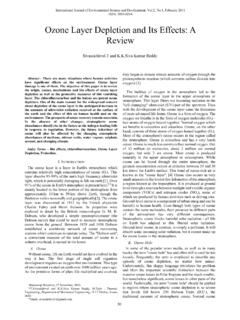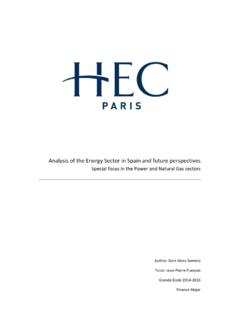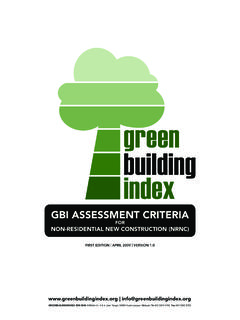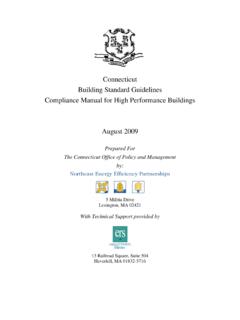Transcription of Design of High Efficiency Cyclone for Tiny Cement Industry
1 Abstract Air pollution is assuming alarming dimensions from industries, automobiles and house hold fuel burning. Cement Industry can be classified as highly air polluting Industry emitting PM (Particulate Matter) into the atmosphere. This pollutant is in the form of PM (Particulate Matter) is required to be control by installing air pollution control equipment like ESP (Electrostatic Precipitators), Bag houses, Wet scrubbers and Cyclone . Cyclone is considered to be cheaper having low maintenance cost. The present paper aims at designing of high Efficiency Cyclone by using STAIRMAND METHOD for a tiny Cement plant. The Efficiency achieved with this Design is of the order of %. Index Terms Air pollution, Cyclone , pm (particulate matter), tiny Cement plant I. INTRODUCTION The tiny Cement plants are having a capacity of ranging from 20tpd to 50tpd.
2 These Cement plant are either based on vertical shaft kiln or rotary kiln technologies. The predominant air pollutant emitted on from such plant is SPM (Suspended Particulate Matter). Control of SPM (Suspended Particulate Matter) can be achieved by installing ESP (Electrostatic Precipitators), Bag houses and Wet scrubbers but these equipments are highly cost intensive and may not be feasible to be installed at such small scale Cement plants on techno-economical front. Hence, under the present context, installation of Cyclone appears to be a reasonable proposition, which is reasonable cheaper and having low operating cost [16]. A. The salient features of the Cyclone are as under [13] [14] 1) Structure without moving parts. 2) Centrifugal force created; tend to drive particles to the wall of Cyclone . 3) Inlet velocity of gas stream transformed into a confined vortex or spiral flow downward between walls of gas discharge outlet and body of Cyclone or main vortex.
3 II. APPLICATION OF Cyclone Applications of Cyclone are as under [14] Manuscript received August 31, 2011, revised October 10, 2011. This work is supported by Kalol Institute of Technology and Research Center, Kalol, India. F. A. Niki Gopani and S. B. Dr. Akshey Bhargava are with Institute of Technology and Research Center, Kalol, Gujarat, India. (e-mail: 1) Sawmill 2) Oil refineries 3) Cement Industry 4) Feed and grain processing 5) Mineral processing 6) Paper and textile Industry 7) Wood working Industry 8) Vacuum cleaners and central vacuum cleaners III. ADVANTAGE OF Cyclone Advantages of Cyclone are as under [14] 1) Low initial cost 2) Simple construction and Operation 3) Low pressure drop 4) Low maintenance requirements 5) It has no moving parts 6) Continuous disposal of solid particulates 7) They can be constructed of any material which will meet the temperature and pressure requirements and the corrosion potential of the carrier gas stream IV.
4 DISADVANTAGE OF Cyclone Disadvantages of Cyclone are as under [14] 1) Low collection Efficiency for particles below 5-10 in diameter 2) Equipment is subject to severe abrasive deterioration. 3) Decreasing collection efficiencies for decreasing dispersoid concentration in the gas stream V. STANDARD Cyclone Design BY STAIRMAND METHOD Stairmand developed two standard Design for gas-solid cyclones (1) High Efficiency Cyclone [1], figure 3(a)and (2) high gas rate Cyclone , figure 3(b)[11].The performance curve for these Design , obtained experimentally under standard test conditions, are shown in figure 4(a) and D(b).[4] This curve can be transformed to other Cyclone sizes and operating conditions by use of the following equation, for a given separating Efficiency [2] D2= [(DC2/DC1)3 X Q1/Q2 X 1/ 2 X 2/ 1]1/2 (1) where, d1=mean diameter of particle separated at the standard conditions, at the chosen separating Efficiency , figure 4(a) or 4(b).
5 Design of High Efficiency Cyclone for Tiny Cement Industry Niki Gopani and Akshey Bhargava International Journal of Environmental Science and Development, Vol. 2, No. 5, October 2011350 D2=mean diameter of the particle separated in the proposed Design , at the same separating Efficiency , DC1=diameter of the standard Cyclone = 8 inches (203 mm), DC2=diameter of proposed Cyclone , mm, Q1=Standard flow rate: For high Efficiency Design =223 m3/h, For high throughput Design = 669 m3/h, Q2=proposed flow rate, m3/h, 1=solid-fluid density difference in standard conditions = 2000 kg/m3 2=density difference, proposed Design , 1=test fluid viscosity (air at 1 atm,200 C) = mNs/m2 2=viscosity of proposed fluid.[10] A performance curve for the proposed Design can be drawn up from , figure 4(a) or 4(b) by multiplying the grade diameter at, say each 10 per cent increment of Efficiency , by the scaling factor given by equation 1 as show in figure 5[5] Fig.
6 1. Reverse-flow cyclones A. Pressure Drop The pressure drop in a Cyclone will be due to the entry and exist losses along with friction and kinetic energy losses in the Cyclone .[12] The empirical equation given by Stairmand (1949) can be used to estimate the pressure drop: P= f/203 {u12 [1+2 2 (2r1/re-1)] +2u22} (2) where, P= Cyclone pressure drop, millibar, pf= gas density, kg/m3, u1= D inlet duct velocity, m/s, u2 =D exit duct velocity, m/s, rt= D radius of circle to which the centre line of the inlet is tangential, m, re =D radius of exit pipe, m, = factor from Figure 2, = parameter in Figure 2, given by: =fc As/A1 Fc= friction factor, taken as for gases, As= surface area of Cyclone exposed to the spinning fluid, m2. A1= area of inlet duct, m2. For Design purposes this can be taken as equal to the surface area of a cylinder with the same diameter as the Cyclone and length equal to the total height of the Cyclone (barrel plus cone).
7 Radius ratio rt/re Fig. 2. Cyclone pressure drop factor Fig. 3. Standard Cyclone dimension as per stairmand (a) high Efficiency (b) high gas rate Cyclone Fig. 4(a) Performance curves for high Efficiency Cyclone International Journal of Environmental Science and Development, Vol. 2, No. 5, October 2011351 Fig. 4(b) Performance curves for high gas rate Cyclone Fig. 5. Scaled performance curve VI. MONITORED DATA An effort was made to monitor the gaseous emission emitted out from the stack attached kiln by adopting standards method for monitoring and analysis. The results of monitoring are shown below: PM concentration without control: 1250 mg/Nm3 Density of particle: 2500 kg/m3 Gas Temperature=150 C Gas flow rate: 4000m3/hour Required Efficiency =90 % Particle size distribution as under TABLE I: PARTICLE SIZE DISTRIBUTION Particle size, m Percentage by weight less than 50 90 40 75 30 65 20 55 10 30 05 10 02 04 VII.
8 Design OF HIGH Efficiency Cyclone BY STAIRMAND METHOD As 10 per cent of the particles are below 05 m the high- Efficiency Design will be required to give the specified recovery. Flow-rate =4000/3600 = m3/s Area of inlet duct, at 15 m/s = = m2 Duct area = Dc x Dc= So, Dc = m This is clearly too large compared with the standard Design diameter of m. Flow-rate per Cyclone = 4000/8=500 m3/h= Here, area if inlet ducts = Now area of inlet duct = x Dc= Dc= meter, which is comparatively safe as it is close to standard size diameter of meter. Density of nitrogen base gas at 150oc =Mol. Weight of nitrogen/mol. Weight of air xToK of air at 00C/ToK of gases =28 x 273/ (273+150) = kg/m2 Which is negligible compared with solid particle density. Viscosity of nitrogen at 1500 C =viscosity of standard air x 28 = = mNs/m2 From equation (1) D2= [(DC2/DC1)3 X Q1/Q2 X 1/ 2 X 2/ 1]1/2 Scaling factor = [( )3 x 223/500 x 2000/2500 x ]1/2 = The performance calculations, using this scaling factor in the table below: TABLE II.
9 OVERALL COLLECTED Efficiency [6] Particle size ( m)Percent in range Mean particle size Scaling factor Efficiency at scaled size %Collected (2) x (4)/100>50 10 41 99 50-40 15 37 98 40-30 10 29 97 30-20 10 21 96 20-10 25 12 94 10-5 20 06 88 5-2 06 03 85 2-0 04 01 25 1 100 Over all collected Efficiency = [6] Hence, the above Design of Cyclone is safe, as the designed Efficiency is more than 90%. Thus, the dimension of the Design Cyclone is as under[8][9]: International Journal of Environmental Science and Development, Vol.
10 2, No. 5, October 2011352 Dc=diameter of Cyclone = m Height of inlet duct=Hi= Dc= Width of inlet duct=wi= Dc = m Diameter of out let duct=D0= Dc = Diameter of dust outlet=Dd= = Length of Cyclone main body = ( ) = Length of Cyclone hopper = Total length of Cyclone =L1+L2= A. Pressure Drop Calculation Area of inlet duct Ai= Hi xWi= m2 Cyclone surface area As = xDcx (L1+L2) = Fc taken as =fcxAs/Ai = = Here, r1=Dc-Wi/2 = = And re=Hi= Thus rt/re = From, fig. 2. = U1 = inlet duct velocity =Flow of air/inlet duct area = = m/s Area of exit duct = D02/4 = = m2 U2=exit velocity = = m/s From equation 2 P= f/203 {U12 [1+2 2 (2r1/re-1)] +2u22} = [ [1+ ( 1)] + ] = millibar =480 N/m2 B. Power Requirement W=Q x P = = watt Fig. 6. Proposed Cyclone Design VIII. CONCLUSION The designed high Efficiency Cyclone gives an Efficiency of % as against the desired 90 % which is safe Design for controlling air pollutant concentration in the form of SPM from kiln attached to the Cement plant.








